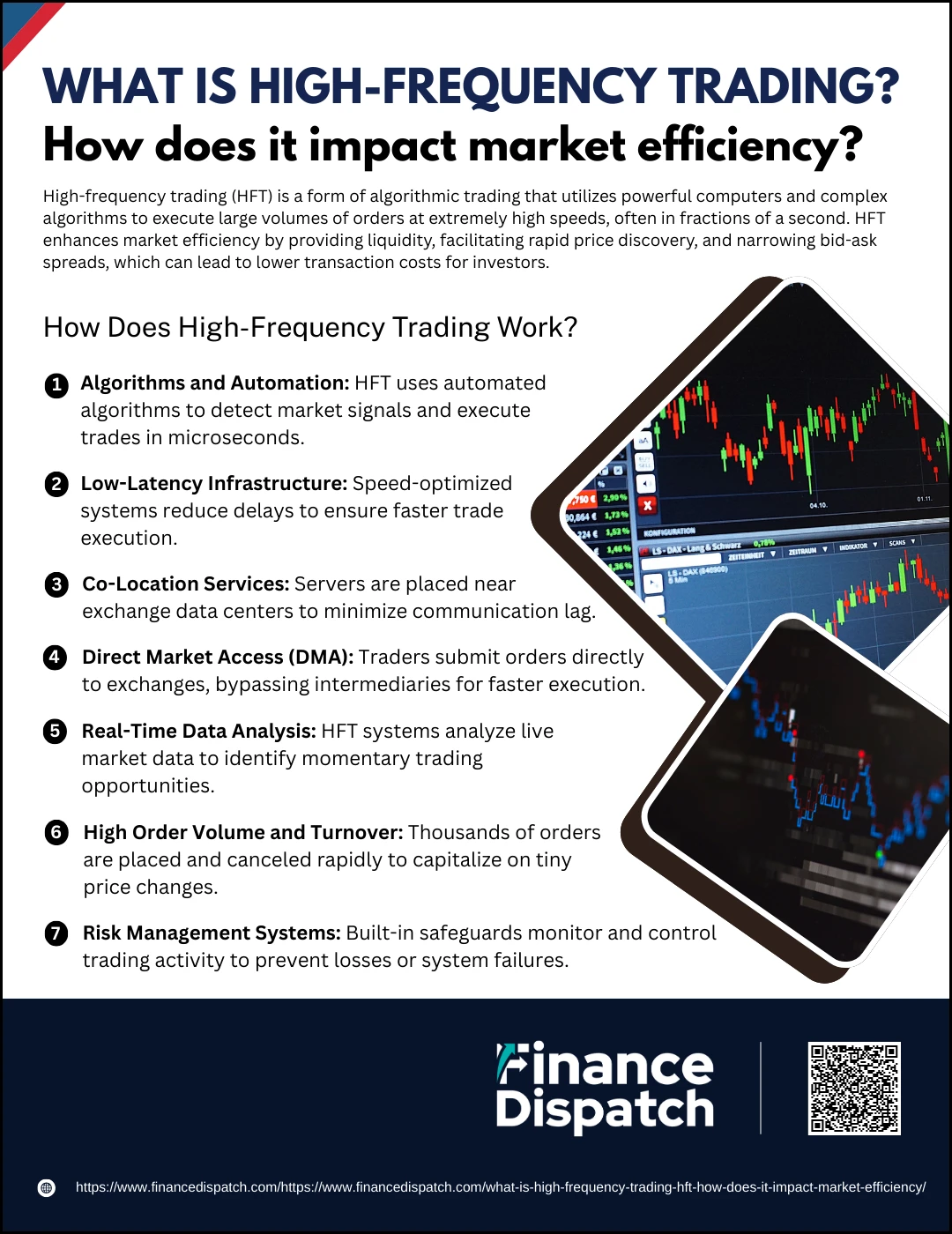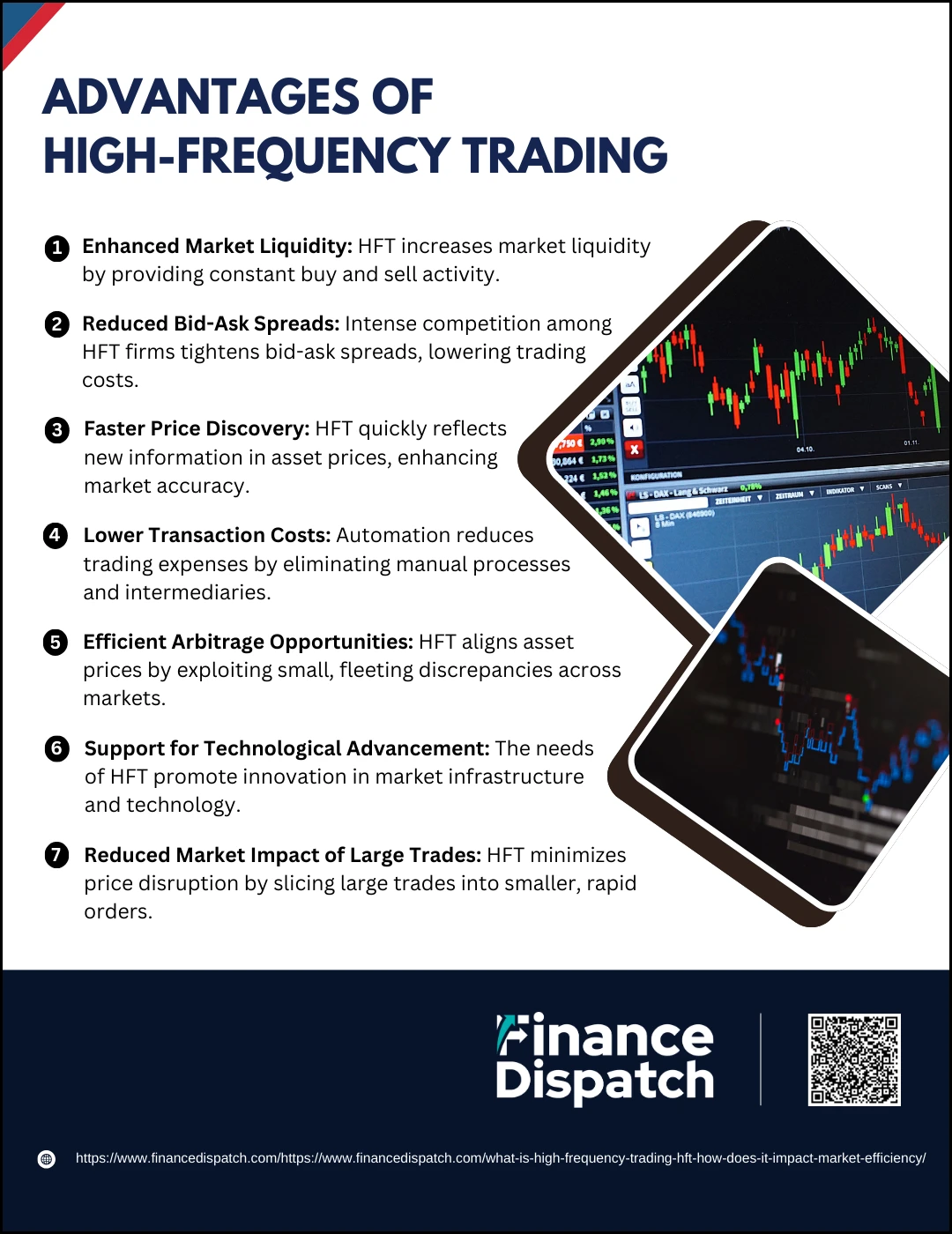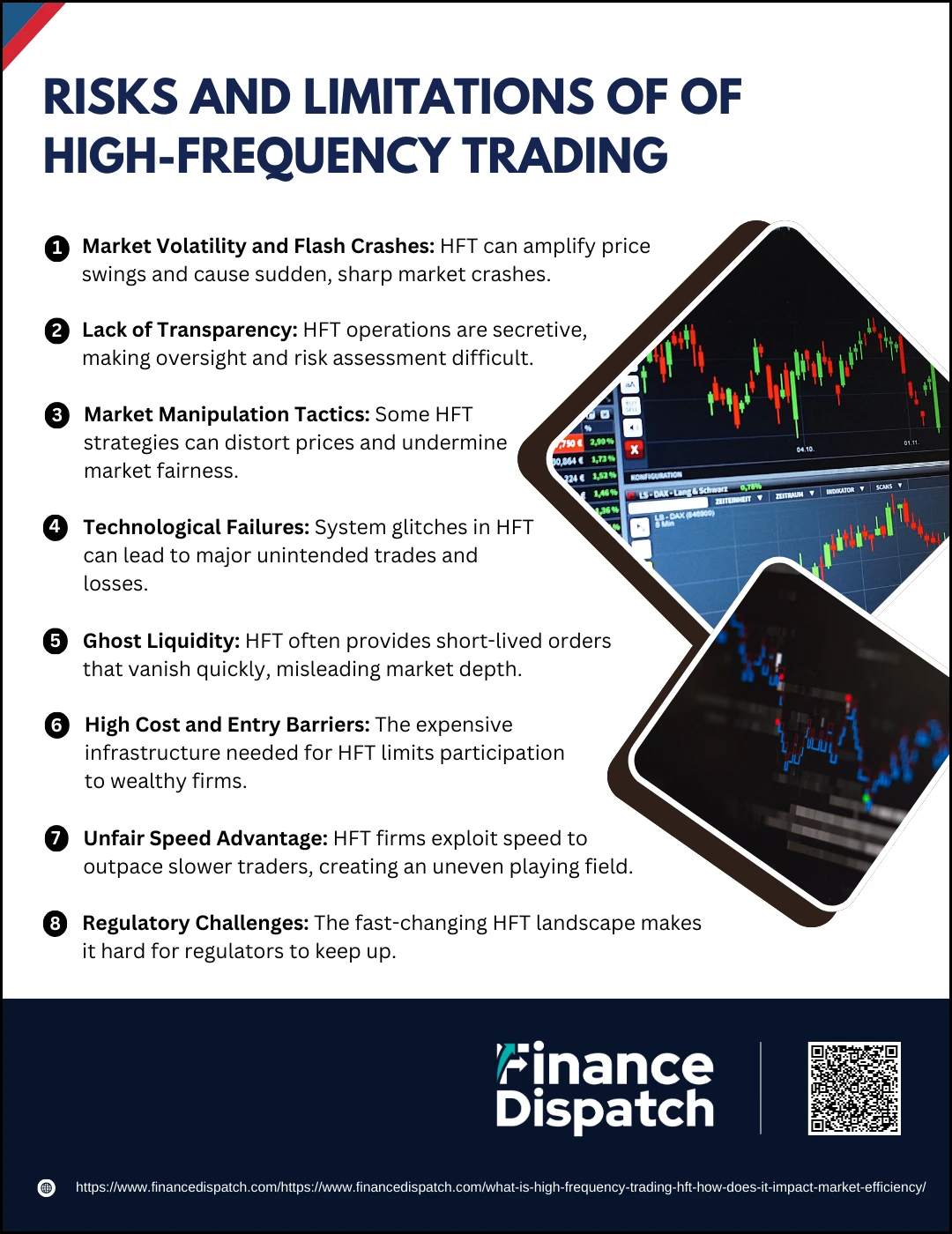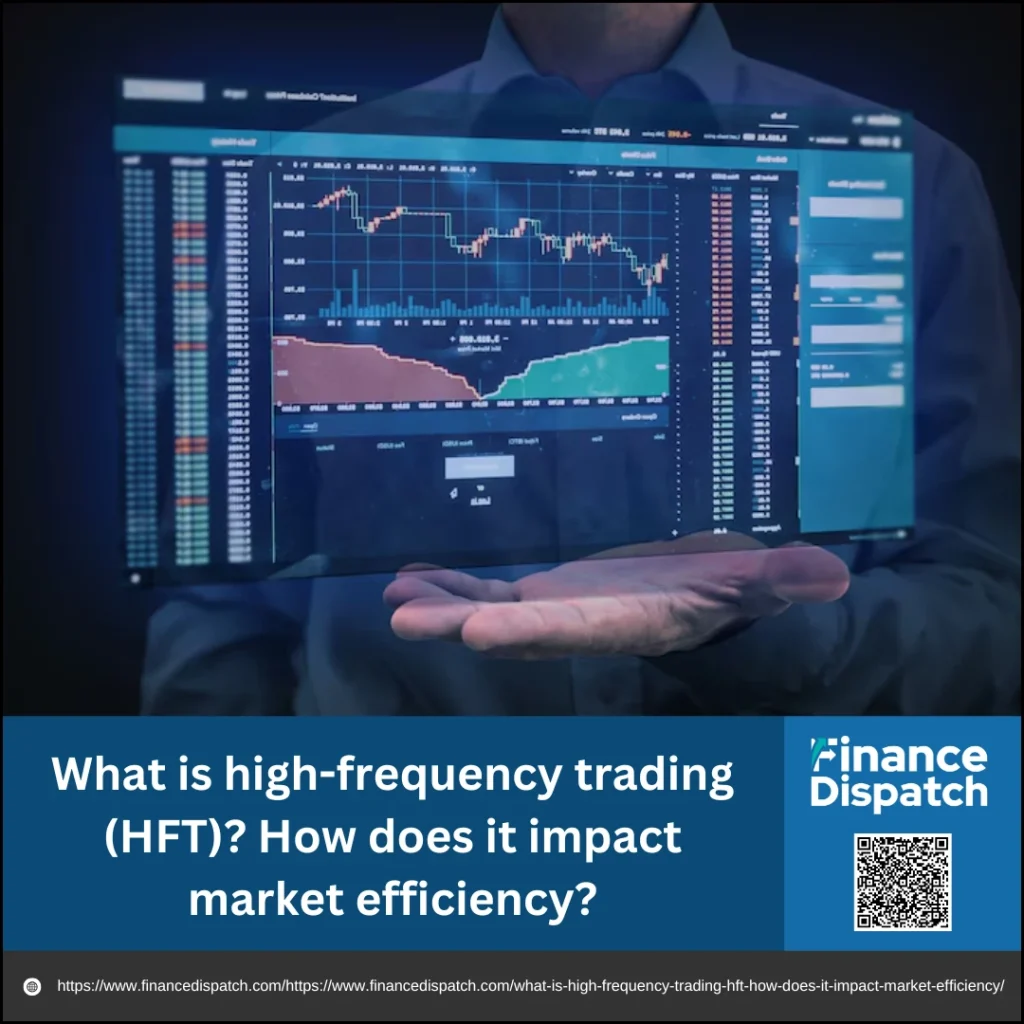In today’s fast-paced financial markets, speed can mean the difference between profit and loss. High-frequency trading (HFT) has emerged as a dominant force in modern finance, where powerful algorithms and lightning-fast computers execute thousands of trades within fractions of a second. This form of algorithmic trading has revolutionized how institutions interact with the market—transforming traditional strategies and raising important questions about fairness, stability, and transparency. As its influence continues to grow, understanding what HFT is and how it impacts market efficiency is essential for investors, regulators, and anyone interested in the mechanics of today’s financial systems.
What is High-Frequency Trading (HFT)?
High-frequency trading (HFT) is a specialized form of algorithmic trading that uses advanced computer systems and complex mathematical models to execute a massive number of trades at incredibly high speeds—often in milliseconds or microseconds. Unlike traditional trading methods that rely on human decision-making, HFT systems analyze market data, identify short-term opportunities, and place orders automatically without manual intervention. These systems are designed to exploit tiny price discrepancies that may exist only for a fraction of a second, allowing firms to generate small but consistent profits at scale. HFT is primarily used by large financial institutions, hedge funds, and proprietary trading firms that invest heavily in low-latency infrastructure to gain a competitive edge in today’s electronic markets.
History and Evolution of HFT
The history of high-frequency trading (HFT) is closely tied to the evolution of electronic financial markets. It began in the early 1980s with the introduction of electronic trading platforms like NASDAQ, which laid the groundwork for computer-based order execution. However, it wasn’t until the late 1990s and early 2000s—following the U.S. Securities and Exchange Commission’s approval of electronic communication networks (ECNs)—that HFT started to gain momentum. As trading speed became a competitive advantage, firms began investing heavily in sophisticated algorithms, low-latency data feeds, and co-location services near exchange servers. By 2009, HFT accounted for a significant share of trading volume in U.S. equity markets. The 2010 Flash Crash brought global attention to HFT’s potential risks, prompting increased regulatory scrutiny. Since then, technological advancements and market structure reforms have continued to shape HFT, making it faster, more complex, and deeply embedded in global trading systems.
 How Does High-Frequency Trading Work?
How Does High-Frequency Trading Work?
High-frequency trading (HFT) functions at the intersection of advanced technology, financial strategy, and extreme speed. Unlike traditional trading, which may rely on longer-term analysis or human judgment, HFT is entirely automated and data-driven. At its core, HFT systems are designed to detect and act on market inefficiencies—tiny price differences that exist for only microseconds—before other traders can react. To do this effectively, firms deploy an arsenal of powerful computers, direct exchange connections, and real-time data analytics. Every microsecond counts, which is why HFT firms spend heavily on infrastructure to ensure their systems can execute trades faster than the competition. Below are the key elements that drive how high-frequency trading works:
1. Algorithms and Automation
At the heart of HFT are algorithms—sets of instructions programmed to recognize specific market conditions and make rapid decisions. These algorithms monitor live data feeds and execute trades without human intervention, often reacting in microseconds to market changes.
2. Low-Latency Infrastructure
Speed is crucial in HFT. Firms invest in low-latency systems—optimized hardware, software, and network architecture—to minimize delays in data processing and trade execution. Even a few microseconds can determine whether a trade is profitable or not.
3. Co-Location Services
To gain an edge, many HFT firms place their servers physically close to exchange servers. This practice, known as co-location, allows them to reduce communication lag and respond to market changes more quickly than firms operating at longer distances.
4. Direct Market Access (DMA)
HFT firms typically use direct market access to submit orders directly to the exchange without going through intermediaries. This not only reduces execution time but also gives them greater control over the order routing process.
5. Real-Time Data Analysis
HFT systems constantly scan market data—including stock prices, volumes, bid-ask spreads, and even news headlines—in real time. This enables them to identify fleeting opportunities for arbitrage or price mismatches across different venues.
6. High Order Volume and Turnover
A typical HFT strategy may involve placing thousands of orders per second, many of which are canceled almost immediately. This high volume and rapid turnover are essential to profiting from very small price changes.
7. Risk Management Systems
Since HFT systems operate without human oversight during trading hours, they include built-in safeguards. These risk management features monitor exposure, check for unusual activity, and can automatically halt trading in the event of system malfunctions or extreme market volatility.
Common HFT Strategies
High-frequency trading (HFT) relies on a variety of specialized strategies designed to exploit minute inefficiencies in the market. These strategies are implemented through powerful algorithms that can analyze vast amounts of data and execute trades within fractions of a second. While all HFT strategies prioritize speed and automation, each one serves a different purpose—some aim to provide liquidity, while others focus on arbitrage or influencing short-term momentum. Below are some of the most commonly used strategies in high-frequency trading:
1. Market Making
HFT firms place both buy and sell orders for the same security to profit from the bid-ask spread. By continuously quoting prices, they help provide liquidity to the market and earn small, consistent profits.
2. Statistical Arbitrage
This strategy involves identifying short-term pricing inefficiencies between correlated securities. Algorithms detect when two related assets deviate from their historical relationship and place trades expecting the prices to converge.
3. Latency Arbitrage
HFT firms exploit tiny time differences in the availability of price information across different trading venues. By reacting faster than others to price updates, they can buy low in one venue and sell high in another almost simultaneously.
4. News-Based Trading
Algorithms analyze news headlines, earnings releases, and even social media for signals that may affect stock prices. They react within milliseconds to act on new information before the broader market adjusts.
5. Momentum Ignition
This involves initiating a series of trades intended to spark short-term price movement. Once the momentum begins, the algorithm rides the wave before exiting with a profit. This strategy is controversial and sometimes scrutinized by regulators.
6. Index Arbitrage
Traders capitalize on price differences between an index and its underlying components. By buying undervalued stocks and selling the overvalued index—or vice versa—they profit when prices align.
7. Quote Stuffing and Spoofing
These are manipulative tactics where firms flood the market with orders they don’t intend to execute to confuse competitors or create false impressions of demand. These practices are illegal in many jurisdictions.
 Advantages of High-Frequency Trading
Advantages of High-Frequency Trading
High-frequency trading (HFT) has redefined the landscape of modern financial markets through its ability to execute trades with extreme speed and precision. By leveraging advanced algorithms and cutting-edge technology, HFT not only benefits the firms that use it but also enhances the overall efficiency of the market. Although it often draws criticism for contributing to volatility or creating an uneven playing field, HFT offers several notable advantages that improve market performance, transparency, and accessibility. Below are the key benefits explained in greater detail:
1. Enhanced Market Liquidity
HFT firms play a vital role in maintaining a liquid market by continuously buying and selling securities. Their presence ensures that there are always counterparties available for trades, even during periods of low activity. This constant participation helps reduce the risk of price gaps and supports smoother market operations.
2. Reduced Bid-Ask Spreads
The competition between HFT firms to capture minimal profit margins results in tighter bid-ask spreads. A narrow spread means traders can buy and sell at prices closer to the market value, reducing the implicit cost of trading for all market participants, especially for retail investors and institutional traders alike.
3. Faster Price Discovery
By processing vast amounts of data in real time, HFT algorithms help incorporate new information into asset prices almost instantaneously. This rapid adjustment leads to more accurate pricing, which reflects current market sentiment, news releases, or economic indicators faster than traditional methods.
4. Lower Transaction Costs
Automation in HFT eliminates the need for manual order placement and reduces reliance on intermediaries. As a result, firms can complete trades at a fraction of the cost compared to conventional trading methods. These savings can extend to the broader market through improved execution quality and reduced brokerage fees.
5. Efficient Arbitrage Opportunities
HFT identifies small price discrepancies across different exchanges or related assets and exploits them before they disappear. This continuous arbitrage activity helps align asset prices across various markets, creating a more unified and efficient pricing system.
6. Support for Technological Advancement
The demands of high-frequency trading have driven innovation in hardware, software, and connectivity. From ultra-low latency networks to real-time data processing, these developments have improved the overall infrastructure of financial markets, benefiting not just HFT firms but also other traders and institutions.
7. Reduced Market Impact of Large Trades
HFT systems are capable of breaking down large orders into smaller, incremental trades executed over milliseconds. This minimizes the chance of triggering significant price movements, allowing large investors to enter or exit positions more discreetly and efficiently.
 Risks and Limitations of HFT
Risks and Limitations of HFT
While high-frequency trading (HFT) offers several benefits to financial markets, it is not without significant risks and limitations. The same speed and automation that make HFT efficient can also amplify systemic vulnerabilities, disrupt fair trading practices, and introduce new challenges for regulators. From market manipulation to technical failures, these drawbacks raise valid concerns about the long-term impact of HFT on market stability and integrity. Below are some of the key risks and limitations associated with high-frequency trading:
1. Market Volatility and Flash Crashes
HFT can intensify price swings during periods of market stress. Algorithms reacting simultaneously to negative signals can trigger sudden sell-offs, leading to extreme volatility or flash crashes—sharp, rapid drops in asset prices that recover quickly but cause panic and losses.
2. Lack of Transparency
The operations of HFT firms are often opaque, with proprietary algorithms and strategies closely guarded. This lack of transparency makes it difficult for regulators and market participants to fully understand their behavior or assess the associated risks.
3. Market Manipulation Tactics
Some HFT practices—such as spoofing (placing fake orders) and quote stuffing (flooding the market with orders to slow others down)—are viewed as manipulative and can distort market signals. These strategies undermine fair competition and may harm less sophisticated investors.
4. Technological Failures
HFT systems rely heavily on technology, and any glitches, coding errors, or connectivity issues can result in massive unintended trades. Given the speed and volume of transactions, a minor system failure can quickly escalate into a large financial loss or disrupt entire markets.
5. Ghost Liquidity
While HFT is known for providing liquidity, much of it is fleeting. Orders may appear and disappear within milliseconds, offering little actual tradeable volume for other market participants. This “ghost liquidity” can create the illusion of a liquid market, only to vanish when it’s most needed.
6. High Cost and Entry Barriers
Engaging in HFT requires substantial investment in infrastructure, data feeds, and co-location services. These high costs create a significant barrier to entry, limiting access to well-capitalized firms and potentially leading to a concentration of market power.
7. Unfair Speed Advantage
HFT firms gain a substantial edge by leveraging speed that other market participants cannot match. This creates an uneven playing field, where retail investors and slower institutions may consistently face disadvantageous execution prices.
8. Regulatory Challenges
The rapid evolution of HFT strategies often outpaces existing regulations. Monitoring, auditing, and enforcing fair practices in such a high-speed environment pose ongoing challenges for regulators worldwide.
How Does HFT Impact Market Efficiency?
High-frequency trading (HFT) has significantly reshaped the way financial markets operate, particularly in terms of efficiency. By leveraging speed, automation, and data-driven decision-making, HFT contributes to faster price adjustments and deeper liquidity. However, its impact is not universally positive. While HFT often enhances the technical efficiency of markets—ensuring prices quickly reflect available information—it can also introduce new inefficiencies through volatility, fleeting liquidity, and unequal access. Understanding both the constructive and disruptive influences of HFT is essential when evaluating its role in modern financial systems. Below are the major ways HFT affects market efficiency, both positively and negatively:
1. Improves Price Discovery
HFT algorithms analyze real-time market data and respond within microseconds to changes in supply, demand, and external events like earnings releases or economic news. This accelerates the incorporation of new information into asset prices, allowing markets to reflect true value more accurately and efficiently.
2. Narrows Bid-Ask Spreads
The fierce competition among HFT firms to place the best bids and offers results in tighter bid-ask spreads. This directly lowers trading costs for all participants and leads to more efficient execution, especially in highly liquid markets like large-cap stocks and ETFs.
3. Increases Market Liquidity
HFT firms continuously place buy and sell orders across various securities, which helps ensure that buyers and sellers can transact at any time. This consistent availability of counterparties contributes to smoother trading conditions and supports market depth.
4. Corrects Short-Term Inefficiencies
HFT strategies like statistical arbitrage or cross-market arbitrage seek to identify and exploit temporary mispricings. These trades force prices to converge quickly to their fair values, thus reducing inefficiencies and improving consistency across related instruments and exchanges.
5. Creates Temporary Volatility
In stressed or rapidly moving markets, HFT systems may simultaneously withdraw liquidity or amplify reactions to short-term signals. This herd-like behavior can lead to rapid price swings—commonly known as flash crashes—that disrupt price stability and hurt investor confidence.
6. Contributes to “Ghost Liquidity”
Although HFT provides large volumes of liquidity, much of it is fleeting. Orders may be canceled almost as quickly as they appear, making the visible depth of the market unreliable. This can mislead slower traders and reduce the practical availability of liquidity when it’s most needed.
7. Disadvantages Slower Traders
HFT firms use ultra-fast infrastructure and co-located servers to react ahead of others. This gives them a significant edge in accessing and acting on information, often at the expense of traditional retail and institutional investors. While this may not violate market rules, it raises questions about fairness and accessibility.
8. Amplifies Systemic Risk
Because many HFT strategies rely on similar signals and technologies, they may react in a synchronized manner to certain triggers, such as market drops or news events. This can cause liquidity to vanish instantly, compounding market stress and increasing the risk of system-wide disruption.
Regulation of High-Frequency Trading
As high-frequency trading (HFT) has grown in speed, complexity, and influence, so too have concerns about its potential to disrupt markets, manipulate prices, and create systemic risks. In response, regulators around the world have introduced various rules to improve transparency, maintain fair competition, and safeguard market stability. These regulations aim to ensure that HFT operates within ethical boundaries and does not undermine investor confidence or the integrity of financial systems. Below are some key regulatory measures and approaches adopted in major financial markets:
1. Pre-Trade Risk Controls
Exchanges and brokers are required to implement controls that monitor trading activity in real time. These include order size limits, price range checks, and capital thresholds to prevent runaway algorithms and unauthorized trades.
2. Order-to-Trade Ratios and Minimum Resting Times
Regulators impose restrictions on excessive order cancellations by introducing minimum resting times or penalties for high order-to-trade ratios. This helps discourage manipulative practices like quote stuffing and ghost liquidity.
3. Kill Switch Mechanisms
Trading systems must be equipped with kill switches—automated tools that can instantly halt trading in the event of system failure, erratic behavior, or market disruptions. This helps mitigate large-scale losses and prevent panic-driven crashes.
4. Mandatory Algorithm Testing and Certification
Firms are often required to test their trading algorithms under simulated conditions and obtain regulatory approval before going live. This ensures that the algorithms behave predictably and comply with market rules.
5. Enhanced Surveillance and Reporting Requirements
Regulatory bodies demand detailed records of HFT activities, including order logs and strategy details. This allows for post-trade analysis and enforcement of compliance in case of suspicious behavior or market abuse.
6. Circuit Breakers and Volatility Controls
Many markets employ circuit breakers that temporarily pause trading during extreme volatility. These help slow down price declines and give traders time to assess market conditions.
7. Co-Location and Data Feed Oversight
Regulators monitor access to co-location services and proprietary data feeds to ensure no firm has unfair speed advantages. Equal access rules are enforced to maintain a level playing field.
8. Ban or Restriction of Manipulative Practices
Activities like spoofing, layering, and momentum ignition are explicitly prohibited in many jurisdictions. Violators face penalties, suspensions, or legal actions.
9. International Cooperation and Guidelines
Global regulatory bodies such as IOSCO (International Organization of Securities Commissions) issue guidelines for harmonizing HFT regulation across markets, promoting transparency, and coordinating responses to cross-border trading risks.
Ethical Debates and Controversies of High-Frequency Trading
High-frequency trading (HFT) has sparked ongoing ethical debates and controversies due to its impact on fairness, transparency, and the structure of modern markets. One major concern is the inherent advantage HFT firms possess through their access to ultra-fast technology, co-location services, and private data feeds—giving them the ability to act on information before other market participants can respond. Critics argue that this creates an uneven playing field where retail investors and slower institutions are consistently disadvantaged. Additionally, manipulative practices such as spoofing, layering, and quote stuffing—though often illegal—have been associated with HFT strategies, raising questions about the intent behind certain high-speed trades. The phenomenon of “ghost liquidity,” where HFT firms place and cancel orders almost instantly, further erodes trust by creating the illusion of market depth without real tradable volume. These concerns have led to increased regulatory scrutiny and public skepticism, as many view HFT as prioritizing profit over the integrity and stability of financial markets. Proponents, however, argue that HFT enhances liquidity and price efficiency, suggesting that the issue lies not in the technology itself but in how it is used.
Future Outlook of High-Frequency Trading
The future of high-frequency trading (HFT) is poised to be shaped by rapid technological innovation, evolving market structures, and tighter regulatory oversight. As firms continue to seek competitive advantages, advancements in artificial intelligence, machine learning, and quantum computing are expected to play a growing role in refining trading algorithms and enhancing decision-making speed. Simultaneously, regulators worldwide are likely to impose stricter rules to ensure market fairness, transparency, and stability—especially in response to concerns over volatility and manipulation. The expansion of HFT into emerging asset classes such as cryptocurrencies and its adoption in global markets with developing infrastructure suggest that the reach of high-speed trading will only grow. However, with increasing competition and diminishing latency advantages, future success in HFT will rely not just on speed but on smarter, more adaptive strategies. Striking the right balance between innovation and ethical responsibility will be critical to ensuring that HFT continues to contribute positively to the evolution of financial markets.
Conclusion
High-frequency trading (HFT) has become an integral part of modern financial markets, transforming the way trades are executed and how prices are determined. Its ability to enhance liquidity, tighten bid-ask spreads, and accelerate price discovery showcases its value in promoting market efficiency. However, these benefits come with notable risks, including heightened volatility, ethical concerns, and unequal access. As technology continues to evolve, so too will the strategies and tools behind HFT. Going forward, the key challenge will be ensuring that innovation in high-speed trading aligns with the principles of fairness, transparency, and market stability. With thoughtful regulation and responsible implementation, HFT can continue to support the growth and integrity of global financial systems.



